An electric vehicle (EV) is a vehicle that uses one or more electric motors for propulsion. Electric vehicles are powered by electricity from a battery or a fuel cell, unlike traditional gasoline-powered vehicles that rely on internal combustion engines.
- Electric vehicles are becoming increasingly popular due to several factors, including:
- Reduced emissions: EVs produce zero tailpipe emissions, which can help improve air quality.
- Lower operating costs: EVs can be cheaper to operate than gasoline-powered vehicles, especially when considering the cost of fuel and maintenance.
- Increased efficiency: Electric motors are more efficient than internal combustion engines, which means EVs can travel farther on a single charge of electricity.
Types of Electric Vehicles
There are four main types of electric vehicles:
1. Battery Electric Vehicles (BEVs)
Battery electric vehicles (BEVs) are fully electric vehicles powered by rechargeable batteries. BEVs do not have a gasoline engine and can only be charged by plugging them into an external power source.
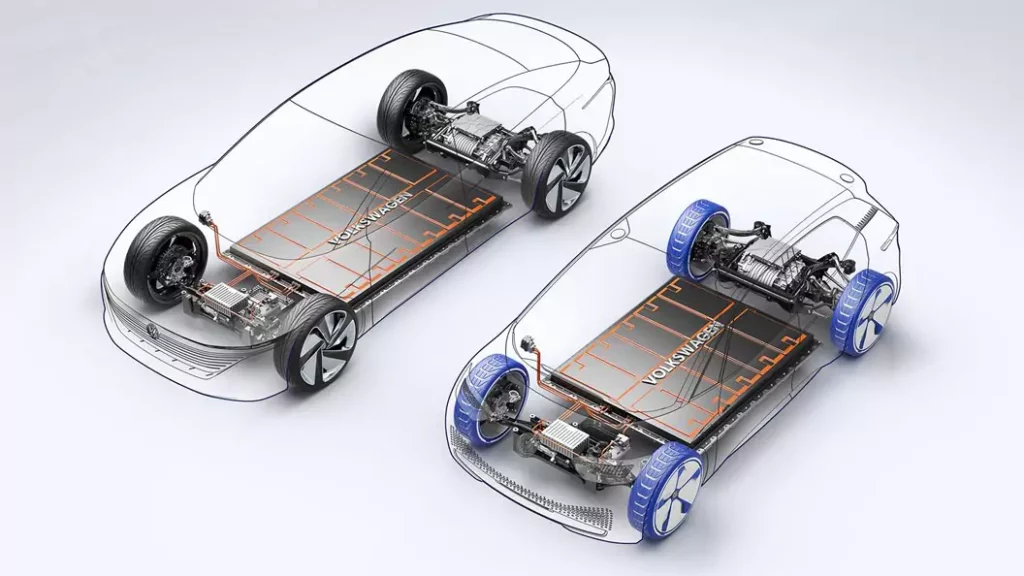
BEVs have a range of approximately 250 to 500 kilometres (150 to 300 miles) on a single charge, depending on the model and battery size. The charging time for a BEV can vary depending on the type of charger used. Level 2 chargers typically charge a BEV in a few hours, while DC fast chargers can charge a BEV in 30 minutes or less.
2. Plug-In Hybrid Electric Vehicles (PHEVs)
Plug-in hybrid electric vehicles (PHEVs) are vehicles that have both an electric motor and a gasoline engine. PHEVs can be charged by plugging them into an external power source, but they can also run on gasoline like a traditional vehicle.
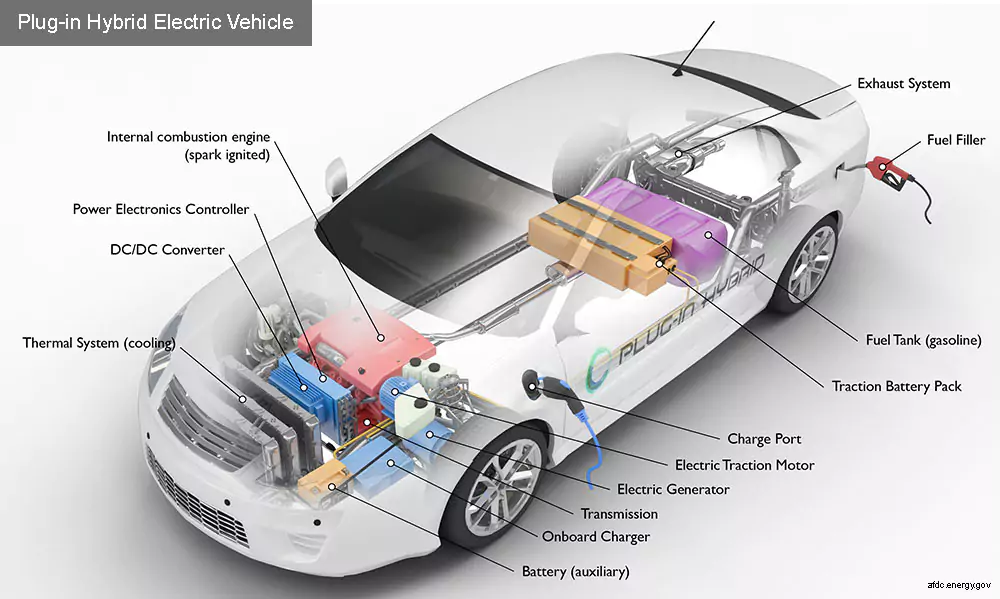
3. Hybrid Electric Vehicles (HEVs)
Hybrid electric vehicles (HEVs) combine an internal combustion engine with an electric propulsion system. Unlike PHEVs, HEVs cannot be plugged in to recharge their batteries. The battery in an HEV is charged by the gasoline engine and regenerative braking, which captures energy from the vehicle when it slows down.
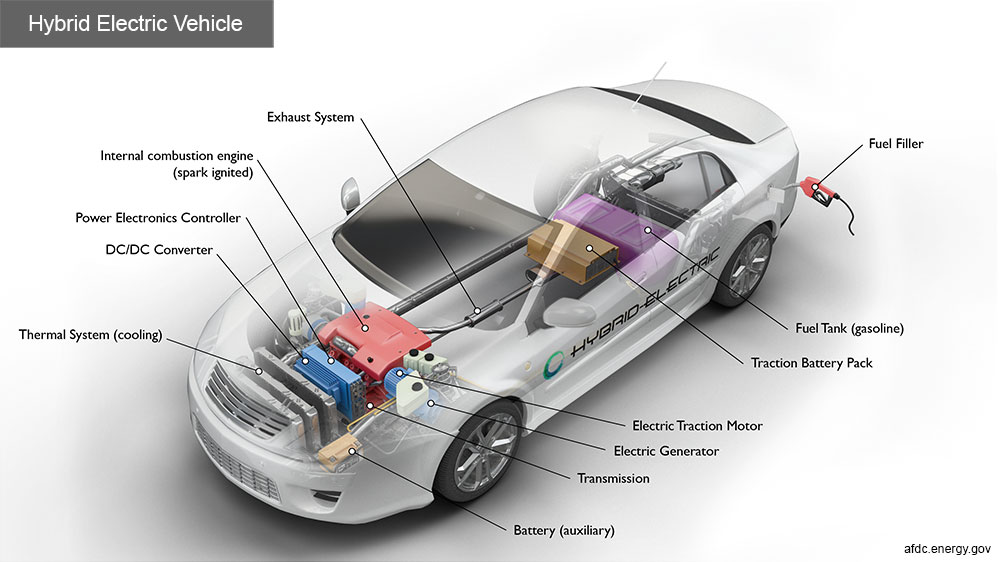
HEVs typically offer better fuel economy than traditional gasoline-powered vehicles, but they do not have the same electric range as BEVs or PHEVs.
4. Fuel Cell Electric Vehicles (FCEVs)
Fuel cell electric vehicles (FCEVs) are electric vehicles that generate electricity through a hydrogen fuel cell. Hydrogen fuel cells combine hydrogen and oxygen to produce electricity, water vapour, and heat. The electricity generated by the fuel cell is used to power the vehicle’s electric motor.
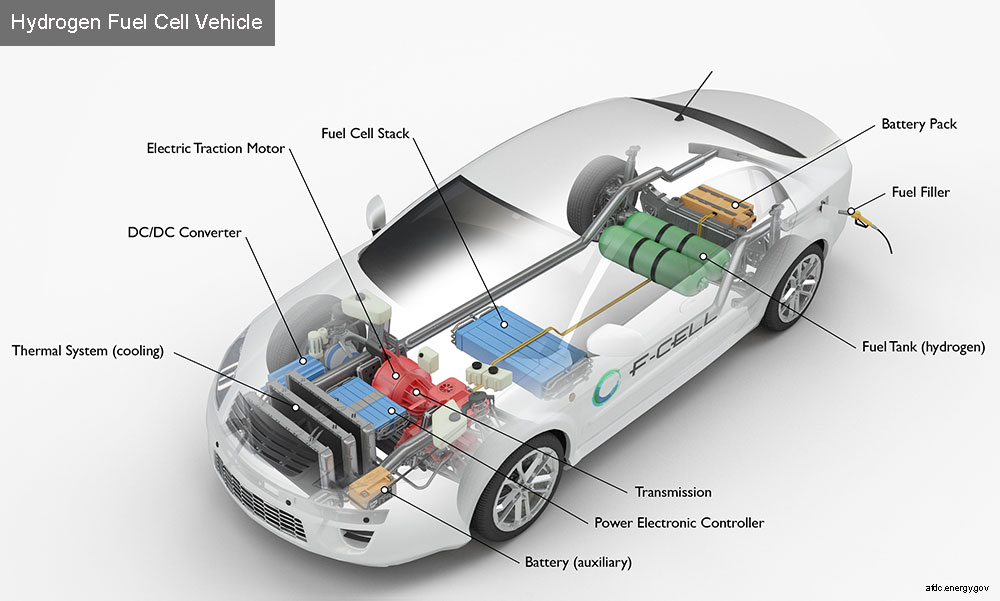
FCEVs have a longer range than most BEVs, and they can be refuelled in a matter of minutes. However, hydrogen refuelling stations are not yet as common as gasoline stations.
Components of an Electric Vehicle
1. Electric Motor
The electric motor in an EV is responsible for converting electrical energy from the battery pack into mechanical energy to rotate the wheels and propel the vehicle. Unlike a gasoline engine, an electric motor produces zero emissions and can deliver instant torque, providing a smooth and responsive driving experience.
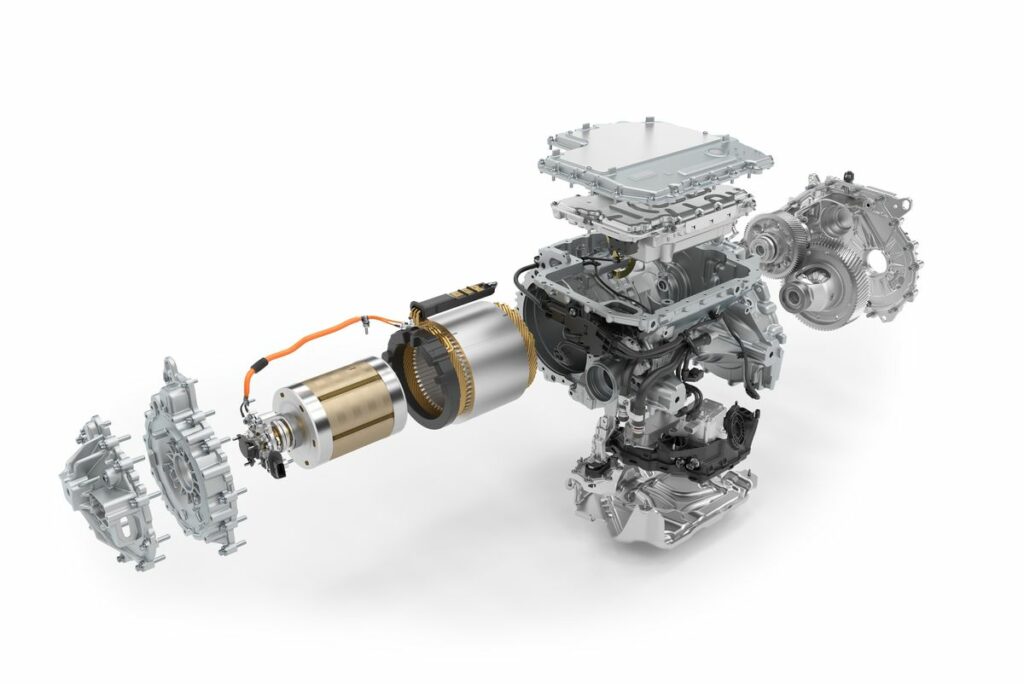
2. Battery Pack
The battery pack is the heart of an EV, storing the electrical energy that powers the electric motor. There are several types of batteries used in EVs, each with its advantages and disadvantages. Common battery types include:
- Lithium-ion (Li-ion): The most common type of battery used in EVs due to its high energy density and long lifespan.
- Lithium-polymer (Li-po): Similar to Li-ion batteries but offer greater flexibility and lighter weight. However, they may have shorter lifespans and are more susceptible to damage from heat.
- Solid-state: A newer battery technology with the potential for longer range, faster charging times, and improved safety. However, solid-state batteries are still under development and are not yet widely available.
The capacity of a battery pack is measured in kilowatt-hours (kWh), which represents the amount of energy the battery can store. A larger battery pack will provide a longer driving range on a single charge.
3. Charging Port
The charging port on an EV allows you to connect the vehicle to an external power source for charging. There are two main types of charging:
- AC Charging Port: Used for Level 1 and Level 2 AC charging. These ports typically use a J1772 connector in North America and Europe, and a Type 2 connector in most of Asia.
- DC Fast Charging Port: Used for DC fast charging. These ports typically use a CCS (Combined Charging System) connector in North America and Europe, and a CHAdeMO connector in Japan.
4. Regenerative Braking System
Regenerative braking is a key feature in EVs that helps to improve efficiency and extend the driving range. When the driver applies the brakes in an EV, the electric motor acts as a generator, converting the kinetic energy of the vehicle into electricity. This electricity is then fed back into the battery pack, storing it for later use.
Regenerative braking can significantly reduce the amount of wear and tear on the friction brakes, as they are used less frequently.
5. Power Electronics
Power electronics play a vital role in managing the flow of electricity in an EV. These electronic components perform several critical functions, including:
- Inverter: Converts the direct current (DC) electricity stored in the battery pack into alternating current (AC) electricity that can be used by the electric motor.
- DC-DC Converter: Regulates the voltage of the battery pack to provide a consistent level of power to the various electrical components in the vehicle.
- Onboard Charger: Converts AC electricity from the charging station into DC electricity for storage in the battery pack (applicable for AC charging).
Charging Infrastructure
Types of Chargers
There are three main types of EV chargers, each offering different charging speeds:· Level 1 Charger: The slowest type of charger, typically found in homes and uses a standard 120-volt AC outlet. Level 1 charging can add up to 5 miles of range per hour.
- Level 2 Charger: Faster than Level 1, typically found in homes, workplaces, and public charging stations. Level 2 chargers use a 240-volt AC outlet and can add up to 25 miles of range per hour.
- DC Fast Charger: The fastest type of charger, typically found at public charging stations. DC fast chargers can deliver a significant amount of charge in a short amount of time, often adding up to 80% of range in 30 minutes or less.
Charging Locations
There are several options for charging an EV:
- Home Charging: The most convenient option for many EV owners. A Level 1 or Level 2 charger can be installed in a garage or driveway.
- Public Charging Stations: A growing network of public charging stations is available in many locations, including shopping centres, parking garages, and along highways.
- Workplace Charging: An increasing number of workplaces are offering charging stations for employees.
Charging Networks
Several companies operate charging networks that provide access to a network of charging stations. These networks often offer apps or websites that allow users to locate stations, check availability, and initiate charging sessions. Some popular charging networks include:
- ChargePoint
- EVgo
- Tesla Superchargers (Tesla vehicles only)
- Electrify America
Charging Time
The charging time for an EV depends on several factors, including:
- Battery size: Larger battery packs take longer to charge.
- Charger type: DC fast chargers are significantly faster than Level 1 or Level 2 chargers.
- Depleted battery level: A battery that is completely depleted will take longer to charge than a battery that is partially charged.
- Vehicle model: Different EV models have different charging capabilities.
Typical charging times are:
- Level 1 charger: 40-50 hours for a full charge
- Level 2 charger: 4-8 hours for a full charge
- DC fast charger: 30 minutes to add up to 80% charge
Note: These are just estimates, and actual charging times may vary.
Benefits of Electric Vehicles
Electric vehicles offer several advantages over traditional gasoline-powered vehicles:
Environmental Impact
- Reduced Greenhouse Gas Emissions: EVs produce zero tailpipe emissions, which can significantly reduce air pollution and help combat climate change.
- Reduced Pollution: EVs also contribute to lower overall emissions, as they don’t emit pollutants like nitrogen oxides and particulate matter associated with gasoline engines.
Cost Savings
- Lower Operating Costs: EVs have lower operating costs than gasoline-powered vehicles. Electricity is generally cheaper than gasoline, and EVs require less maintenance due to fewer moving parts.
- Government Incentives: Many governments offer tax credits, rebates, and other incentives for purchasing EVs, which can significantly offset the initial purchase price.
Performance
- Instant Torque: Electric motors provide instant torque, which translates to smooth and responsive acceleration, offering a more exhilarating driving experience compared to gasoline vehicles.
- Smooth Acceleration: The lack of a complex transmission system in EVs contributes to a smooth and quiet driving experience.
- Quiet Operation: EVs are significantly quieter than gasoline-powered vehicles, reducing noise pollution.
Energy Independence
By relying on electricity, EVs can reduce dependence on fossil fuels and contribute to a more sustainable energy future. Electricity can be generated from renewable sources like solar and wind power, further enhancing the environmental benefits of EVs.
Challenges and Considerations of Electric Vehicles
While EVs offer significant advantages, there are also some challenges and considerations to be aware of:
Range Anxiety
- Driving Range: One of the main concerns with EVs is range anxiety, which is the fear of running out of battery power before reaching a charging station. While the driving range of EVs has been steadily increasing, it is typically less than that of gasoline-powered vehicles on a single tank of fuel.
- Solutions for Range Anxiety:
- Careful trip planning to ensure charging availability along the route.
- Utilizing public charging networks that are becoming increasingly widespread.
- Technological advancements are leading to the development of batteries with longer ranges.
Charging Infrastructure
- Availability: The availability of charging stations, particularly DC fast chargers for long trips, is still not as widespread as gasoline stations.
- Distribution: Charging stations are often concentrated in urban areas, and rural areas may have limited options.
Upfront Cost
- Higher Initial Cost: The upfront purchase price of an EV is typically higher than a comparable gasoline-powered vehicle. However, government incentives and potential savings on operating costs over time can help offset this difference.
Battery Life and Recycling
- Battery Lifespan: EV batteries do degrade over time and eventually need to be replaced. However, battery technology is constantly improving, and most EV batteries are warranted for several years or up to a certain number of miles.
- Battery Recycling: Recycling processes for EV batteries are still under development, but there are ongoing efforts to create more sustainable and efficient recycling methods.
Government Policies and Incentives in Australia
The Australian government is actively promoting the adoption of electric vehicles through various policies and incentives:
Incentives and Rebates
- Federal Incentives: The Australian government offers financial incentives for EV purchases through the “Zero Emission Vehicle (ZEV) Subsidy Scheme.” This scheme provides rebates to eligible consumers who purchase a new battery electric vehicle (BEV) or hydrogen fuel cell electric vehicle (FCEV).
- State and Territory Incentives: Several states and territories in Australia also offer their own EV incentives, including tax breaks, registration fee exemptions, and toll discounts. These incentives vary by location, so it’s important to check with your local government for details.
Regulations and Standards
- Emission Standards: Australia has adopted emission standards that are aligned with international regulations. These standards are designed to encourage the uptake of cleaner vehicles, including EVs.
- Fuel Economy Regulations: Fuel economy regulations are also in place to promote more efficient vehicles and reduce greenhouse gas emissions.
- Safety Standards: All vehicles sold in Australia, including EVs, must meet strict safety standards to ensure passenger protection.
Infrastructure Development
- Government Funding: The Australian government is investing in the development of charging infrastructure to address range anxiety and make EVs a more practical choice for consumers. This includes funding for the installation of public charging stations, particularly in regional areas.
- Collaboration with Private Sector: The government is also collaborating with the private sector to encourage investment in charging infrastructure and expand its reach across the country.
Market Trends and Future Developments
The electric vehicle market in Australia is experiencing significant growth:
Increasing Adoption
- Global and Regional Trends: The global EV market is experiencing rapid growth, and Australia is following this trend. While EV sales still represent a small portion of the overall market in Australia, the numbers are steadily increasing.
- Factors Driving Growth: Government incentives, growing consumer awareness of environmental issues, and a wider range of EV models available are all contributing to the rise in EV adoption in Australia.
Technological Advancements
- Battery Technology: Battery technology is constantly evolving, leading to longer driving ranges, faster charging times, and potentially lower costs.
- Autonomous Driving: The development of autonomous driving technology could further enhance the appeal of EVs by improving safety and convenience.
- Connectivity: Advanced connectivity features can improve the driving experience and allow for better integration with charging infrastructure.
New Models and Manufacturers
- More Options: A growing number of auto manufacturers are introducing new EV models, offering consumers a wider range of choices in terms of styles, sizes, and price points.
- Traditional and New Players: Both established car companies and new EV startups are entering the market, fostering innovation and competition.
Integration with Renewable Energy
- Renewable Energy Sources: The rise of EVs can create synergies with renewable energy sources like solar and wind power. By using clean electricity to power EVs, emissions can be further reduced.
- Sustainable Transportation System: A future powered by renewable energy and electric vehicles can lead to a cleaner and more sustainable transportation system.
Conclusion
Electric vehicles are transforming the transportation landscape, offering a cleaner, quieter, and more efficient alternative to traditional gasoline-powered vehicles. While challenges remain, such as range anxiety and charging infrastructure limitations, the Australian government’s policies and incentives, technological advancements, and increasing consumer interest bode well for the future of EVs in Australia. As the market continues to evolve and EVs become more affordable and practical, they are poised to play a major role in shaping Australia’s future of sustainable transportation.
